Day 3 of a three day long weekend of tours, our last day, and it was time to head down to the Brecks today. The weather forecast was the best of the three days, and even though it was perhaps a little cloudier than we were expecting, it was largely dry and there were some nice bright spells particularly in the morning.
As we stopped briefly in Swaffham on the way down, the sun was out and the sky was blue. With a good breeze blowing, that meant it looked like perfect conditions for Goshawks, so we headed straight over to a favourite spot. We weren’t even out of the car before we saw our first Goshawk – a young female, big and bulky, brown above and orange-tinged below, was circling just above the trees. We all jumped out and had a good look at it, before it disappeared back over the tops.
Over the next hour or so, we were rarely without a Goshawk up in the air. An adult, silvery grey above and white below, was displaying away in the distance, with heavy exaggerated wingbeats. Then another adult appeared much closer, low over the trees, flying around behind us where it caused pandemonium amongst the pigeons and corvids in the field.
An adult male Goshawk appeared high overhead, dropping towards the trees in a long flat glide. As it got closer, it started to descend quickly and we looked over to see why – another juvenile Goshawk, this time a young male, was starting to display over the tops of the firs. The adult swooped at the youngster, but the latter wasn’t giving up easily and twisted, talons up to defend itself. The two of them chased through the treetops for a couple of seconds before disappearing into the trees.
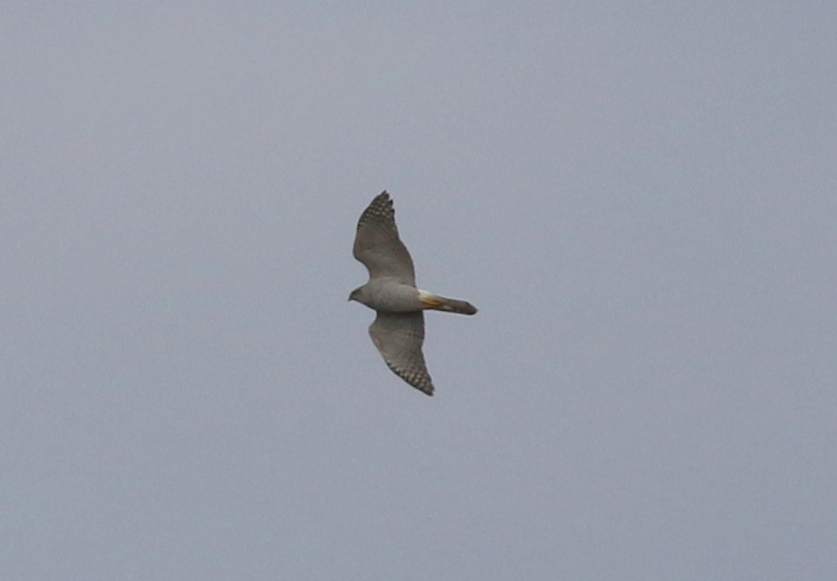
But the best moment of all was when an adult female Goshawk came slowly across over the edge of the trees in front of us. It was a nice flyby and gave us a great look at it, but halfway across it suddenly turned towards us and dropped down in front of the trees. It was flapping powerfully now, with purpose. Ahead of it, a male Pheasant was strutting in the field with its back to the trees, oblivious. The Pheasant realised just in time, panicked and ran towards a cover strip in the middle of the field. It dived in, the Goshawk turning sharply and looking to follow it, but decided against it at the last minute. Wow!
There were a few other raptors up too this morning. A Red Kite drifted lazily over the trees. Several Buzzards circled up, as did a couple of distant Kestrels. A Sparrowhawk flew across, much smaller than the Goshawks and with bursts of much faster flapping flight.
It had clouded over, so we decided to move on to look for Woodlarks. There were none singing when we arrived at a favourite clearing – it was rather cold in the breeze now, with the sun in – so we decided to have a walk round to see if we could find one. We didn’t have to go too far, before we heard a Woodlark calling, the distinctive ringing double ‘tlu-lee’, and looked up to see it flying high towards us. A second Woodlark called from the ground in the middle of the clearing and the first circled round and dropped down nearby.
Before we could get the scope on it, the two Woodlarks were off again, flying across the path and landing in another clearing a bit further over. They were quickly followed by a second pair, which flew over in the same direction but landed in the top of a young oak tree. We got a look at them distantly through the scope before they too dropped down into the grass.
We walked over to see if we could get a closer look. The grass in this clearing is much longer and the Woodlarks were very hard to see at first on the ground, out in the middle. We scanned carefully from along the edge, looking down the line of each row of newly planted trees, before we heard one calling softly. By positioning ourselves carefully, we could see one of the Woodlarks creeping around in the grass.
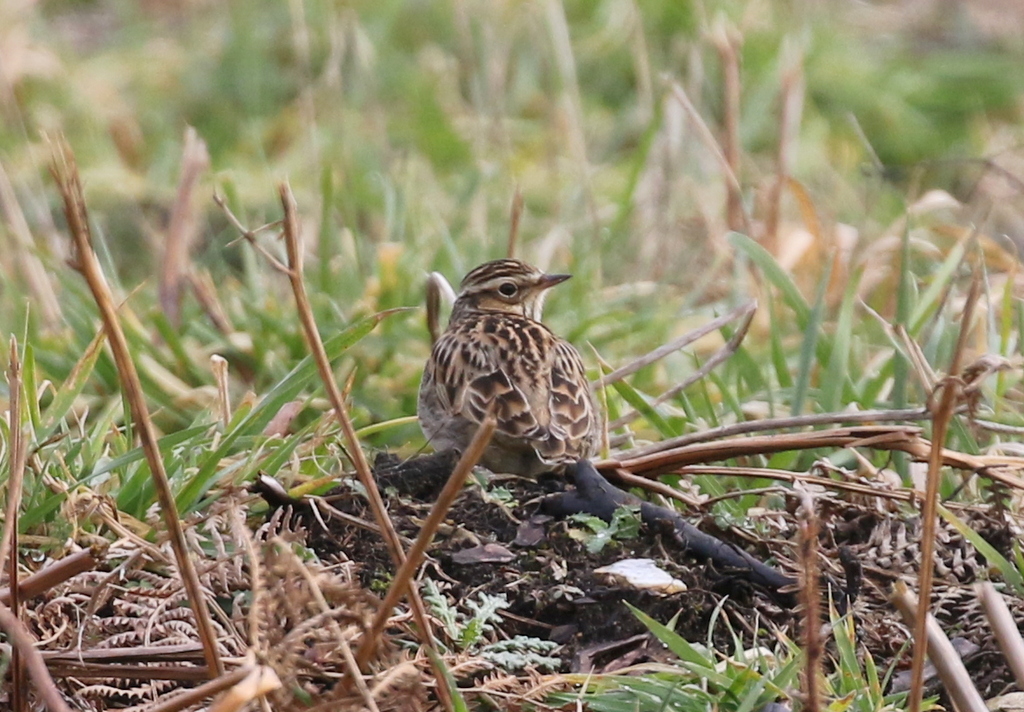
When we lost sight of the first, we spotted a second Woodlark nearby. It perched on a small mound of bare earth for a couple of seconds, sub-singing quietly. Then something spooked them, and all four Woodlarks came up out of the grass and flew round calling, before landing back down again.
Otherwise, the clearings here were rather quiet today. A Common Buzzard appeared briefly above the trees, but raptor activity seemed to have tailed off a bit now. With our mission here accomplished, we decided to move on.
There has been a flock of Parrot Crossbills around the Santon Downham area since November last year, but they can be very elusive. As specialised pine cone feeders, they have lots of trees to choose from here – Thetford Forest is the largest lowland pine forest in the UK! However, they need to drink regularly and will sometimes come in to the same puddles for water. After disappearing for a few days, they had been seen coming to drink yesterday at one of the car parks, so we thought we would have a go at catching up with them.
When we arrived at the rough forestry car park, there were a few people standing around looking down at the muddy puddles. They told us the Parrot Crossbills had been seen coming to drink earlier, which was definitely a good start. We drove round to one of their other favoured areas nearby, but there was no sign of them there. However, we did bump into someone we knew who told us he had seen the Parrot Crossbills coming to drink over an hour before. That meant they were just about due to come back for more, so we headed straight back to the first car park to await them.
It seemed an opportune moment for an early lunch, while we waited for them to appear. We hadn’t even finished unpacking the sandwiches before we heard the Parrot Crossbills calling and turned to see them landing in the top of the oak trees just across the road. We got them in the scope, as they perched there calling quietly, working up the courage to come down to drink. There were at least 15 of them.
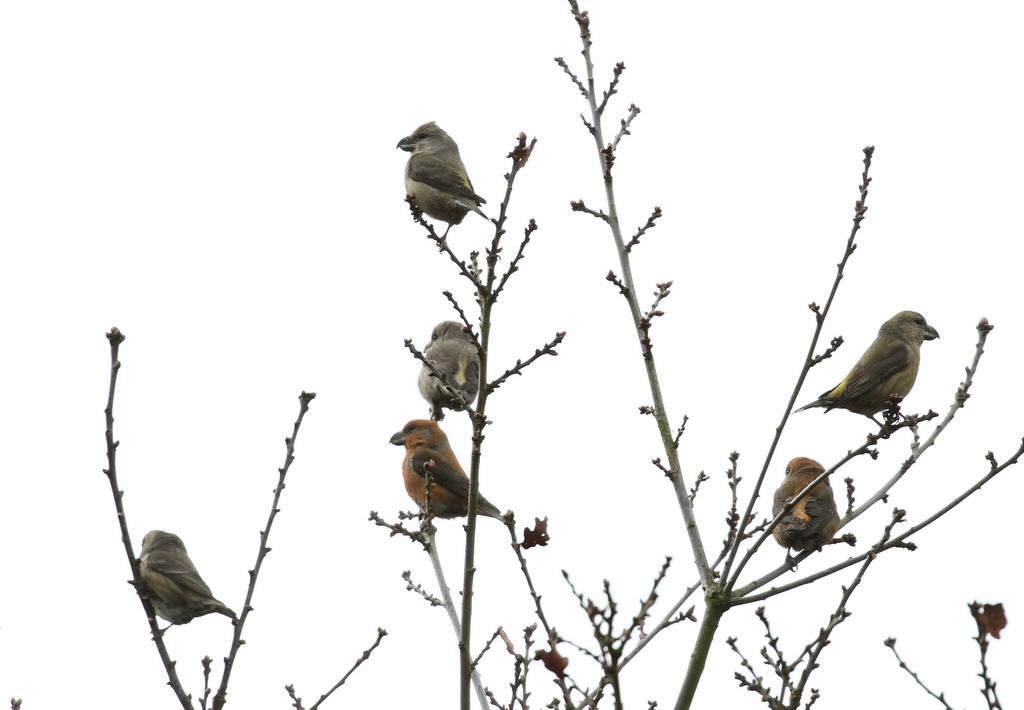
Eventually, the Parrot Crossbills flew across and landed in a smaller tree right on the edge of the car park, just beyond the puddles. Then one or two at a time, they dropped down to the water’s edge and started drinking. From where we were parked, they were only a few metres away from us and we enjoyed stunning views as they came down to the ground.
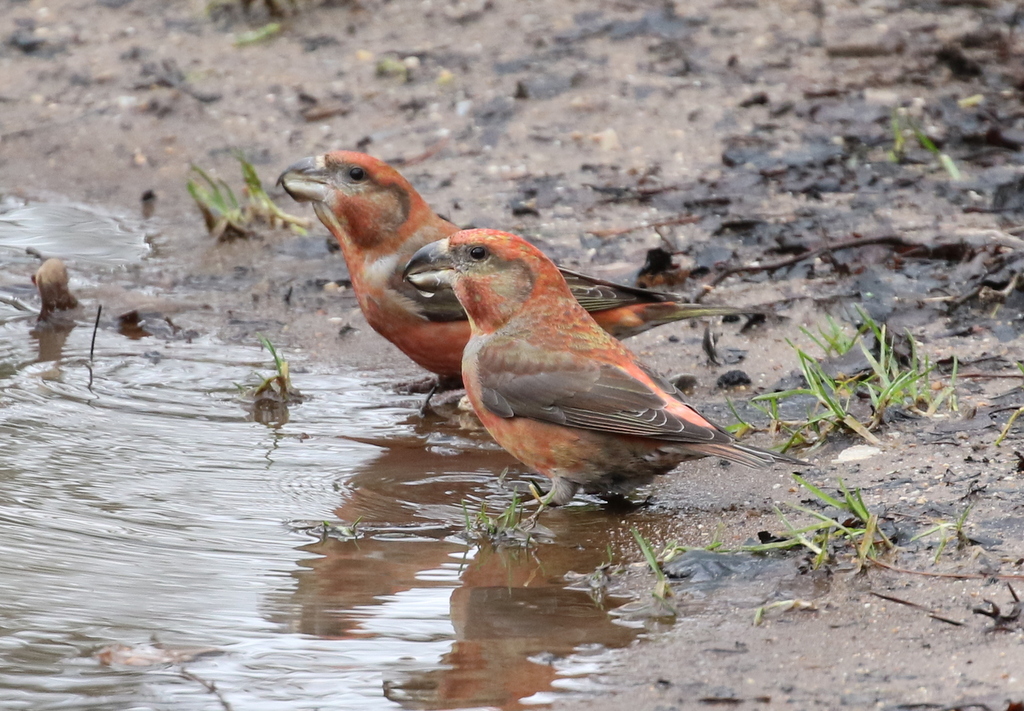
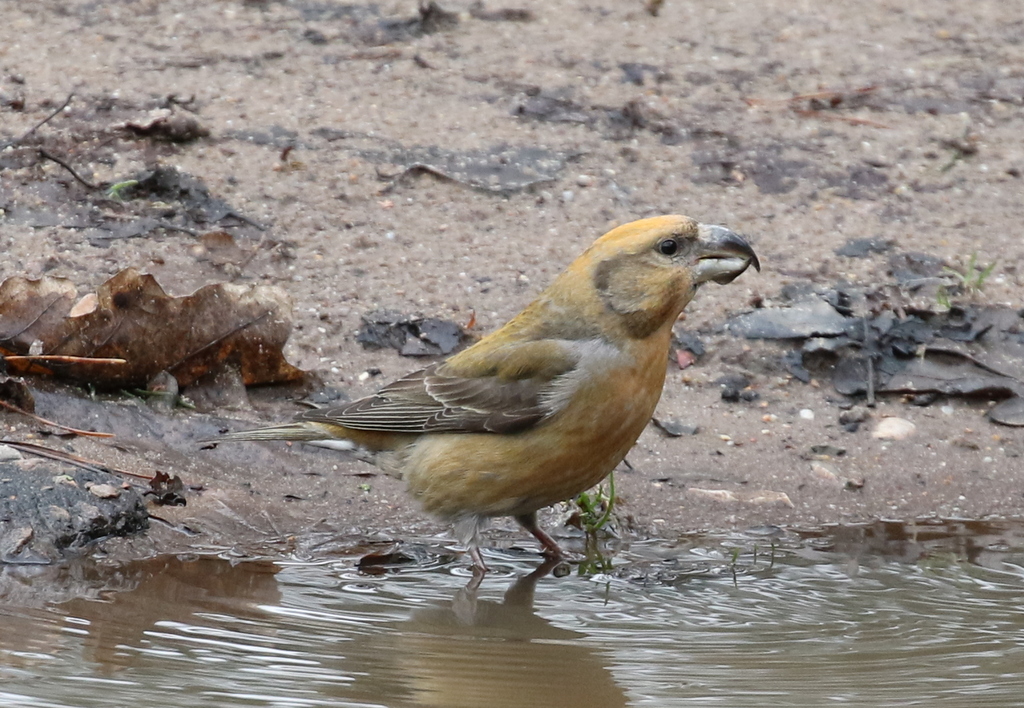
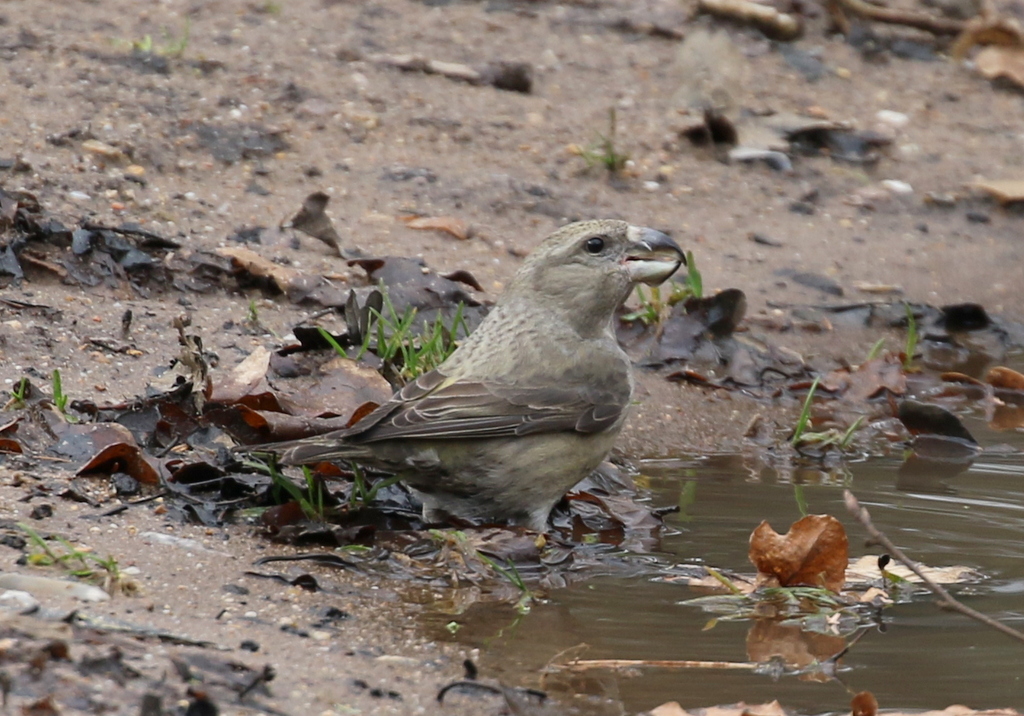
Close up, we could see the Parrots Crossbills’ huge bills and heavy, bull-necked heads, packed with the muscles for pulling open tightly closed pine cones. They were a mixture of red or orange males and grey-green females. Most of them look like they are probably young birds, presumably the class of 2017, though they are not always easy to age.
Parrot Crossbills are very scarce visitors here. Breeding mainly from Scandinavia across into Russia (with smaller numbers in Scotland too), like other crossbills they are an irruptive species, moving south and west in response to any shortage of cones in their home range, but rarely making it as far as southern England. So it is a real treat to see them here, and to see them so well.
Lunch had been forgotten with all the excitement, but after the Parrot Crossbills had finished drinking and flown off back to wherever they were feeding, we turned our attention to our food. Having not had to wait long to see them, we now had a bit of time to play with, so we decided to walk down along the river bank after lunch.
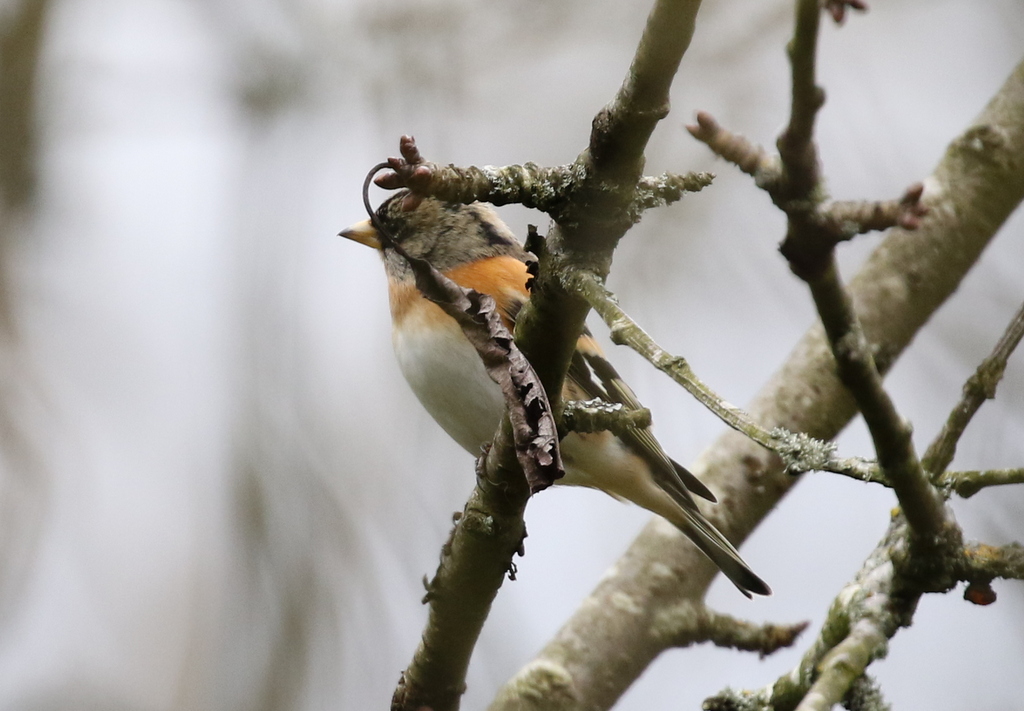
At the feeders by the bridge, a Brambling flew up from the grass and perched briefly in the trees. In the poplars by the river, a Great Spotted Woodpecker was drumming. We had hoped we might get lucky and run into a Lesser Spotted Woodpecker here, but it was rather cold and cloudy now and the trees were rather quiet as we walked down along the river bank.
A Treecreeper called from the poplars and we could just see it high in the trees, though it was hard to get onto and then disappeared back out of view. A few Siskins flew back and forth overhead, calling. There were couple of Little Grebes diving in the river. We stood and listened in the trees for a couple of minutes, but all was quiet. We decided we were better off spending the rest of the afternoon elsewhere.
On the walk back, a couple of Water Rails squealed from the back of the reeds below the poplars. We saw some movement the other side of the river, and picked up a Mistle Thrush, a Song Thrush and a Redwing, all feeding in the same area in the rough paddocks below the alders.
We headed round to Lynford Arboretum for the rest of the afternoon. Hawfinch was our main target here and as it was cool and cloudy now, we decided to head straight down to the paddocks. We were quickly rewarded with a distant Hawfinch in the fir trees at the back, so we made our round for a closer look. It was perched on the edge of the trees, so we could get a good view of it from this side, its huge head and massive bill, strong enough to crack cherry stones, and its ornamental shaped inner primaries.

A second Hawfinch flew in and landed in the tree next to it, the two of them staying there together for several minutes before dropping back into the trees. Rather than wait to see if any more Hawfinches would come in this afternoon, we decided to go and explore the arboretum.
A quick walk round the lake produced a few waterbirds for the day’s list – a few Canada Geese and a single Greylag, several Mallard and a pair of Gadwall, and another Little Grebe. A flock of Redwings were flushed out of the alders and flew out to the hornbeams in the middle of the paddocks, where we could get a good look at them through the scope.
There was some seed put out for the birds on the pillars and posts around the bridge, so we stopped a while to see what would come in. There was a steady stream of tits – Blue, Great, Coal and Long-tailed Tits, plus several Marsh Tits giving us nice close views. A Nuthatch chased everything else off the peanut feeder hanging in the tree above and spent several minutes jabbing ferociously at the peanuts. A Treecreeper worked its way up one of the trees right next to the bridge, so we could get a good look at it. There were several Siskins in the trees here too.
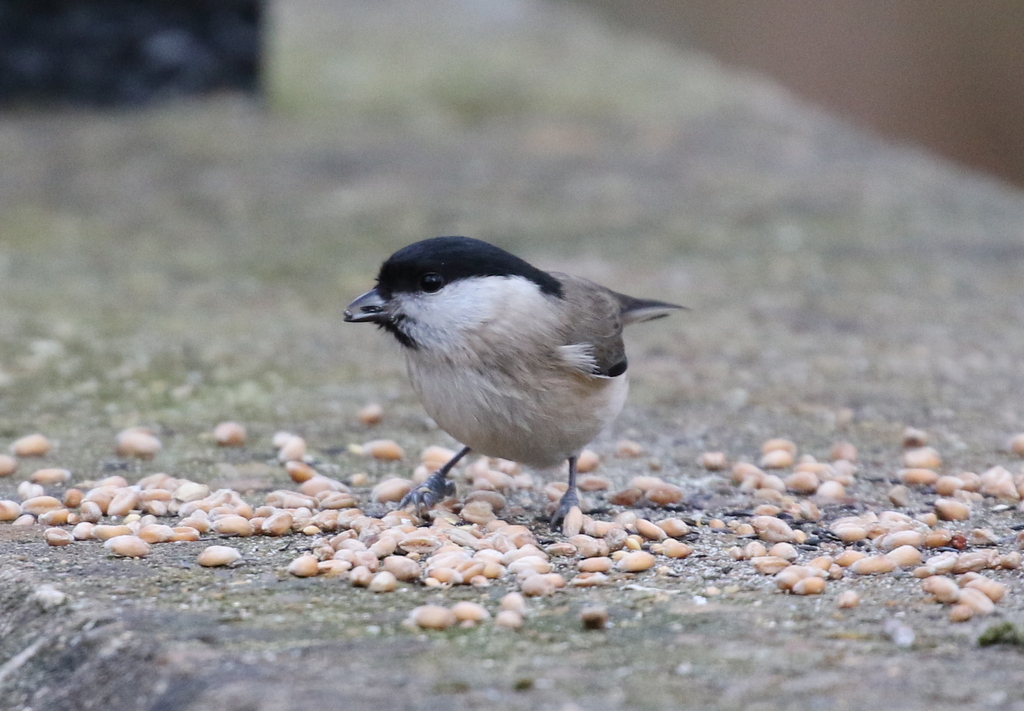
It was time to start thinking about heading back now. There has been a Firecrest around the car park here on occasion, but when we got to the car there was no sign of it. We stood for a while and listened, but there were just a few Blue Tits, a Robin and a couple of Nuthatches piping noisily from high in the trees.
It was only as we were getting in to the car that we heard the Firecrest call from the trees nearby. It flew across and disappeared into some dense young firs, still calling. We walked over and could just see it flitting around on the edge of the trees, before it disappeared in deeper, out of view.
As we made our way back north, driving into Swaffham, we could see thousands and thousands of Starlings whirling over the town. It was quite a spectacle. There has been a murmuration here for the last couple of winters, and numbers really start to grow at thsi time of year, presumably as birds start to make their way back towards the continent. We stopped in the market place and watched them for a while, whirling round overhead. They were quite spread out this evening, but it was still amazing to watch them all, there must have been at least 30,000 birds!
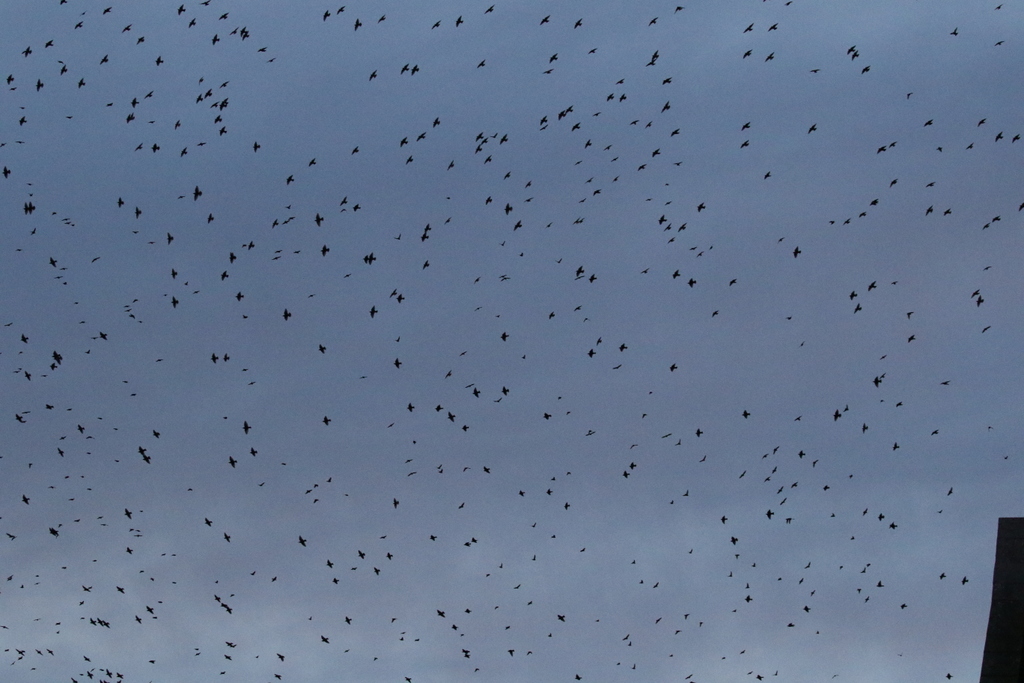
The Starlings were a nice way to round off our three days. It had been very exciting stuff, the best of late winter in the North Norfolk, the Broads and the Brecks. We had seen some great birds, lots of great moments and good company too.
















